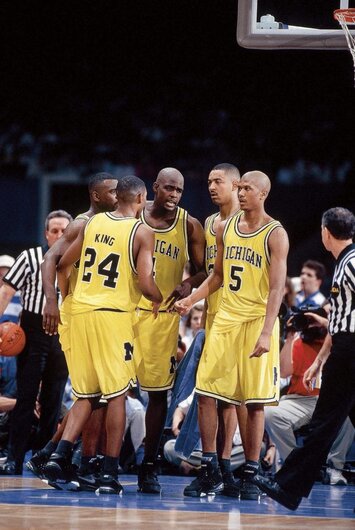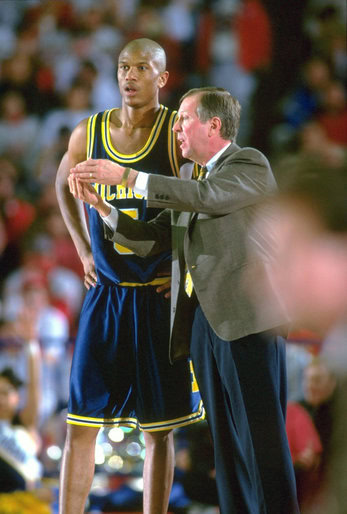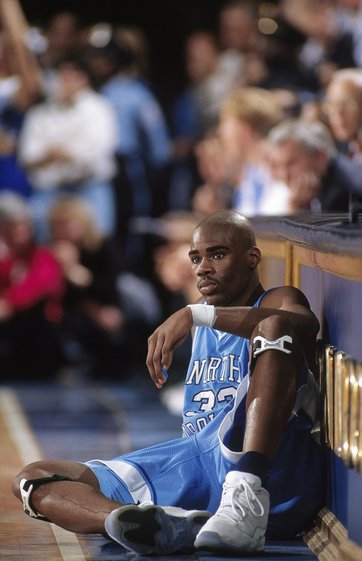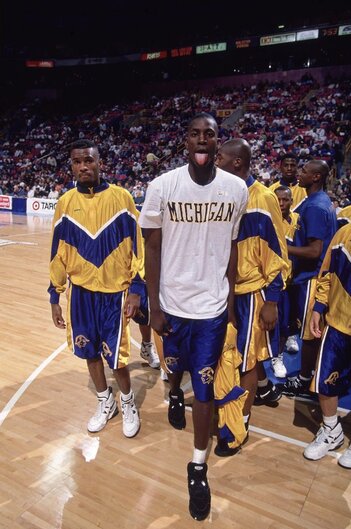30 years ago, five freshmen took hip-hop to the hardwood in the most unexpected of places. Three decades later, their footprints are still all over basketball, business, and pop culture.
Hip-hop was born in 1973. So were the five most influential freshmen ever to step on campus at the University of Michigan.
Calling themselves 5X’s, but better known as the Fab 5, the crew’s fearless leader, Jalen Rose, embodied the swag, style, and spirit that would change the basketball world and keep the scrutinized pack afloat.
As a high school hoop star in Detroit, a young Rose could be caught rocking a gold tooth in tribute to Larry Johnson and Slick Rick. Moving west to Ann Arbor as an undergrad, Rose could be spotted walking around South Quad with a piece of tissue in his nose as a nod to Redman.
Though the state of Michigan was miles away from the Mecca of New York where hip-hop was born, the musical movement had since been rebranded by every NYC borough, soon spreading its wings across the country by the time Jalen and his teammates arrived in academic Ann Arbor.
In the early ’90s, it appeared rap music had penetrated every corner of America.
Well, almost every corner.
On February 9, 1992, hip-hop descended on South Bend, Indiana — a historic site known for clean-cut tradition and sports built on structure.
Unbeknownst to Fighting Irish fans, Notre Dame’s first hip-hop concert was set to take place, performed by five freshman hoopers set to start together for the first time in their young careers.
Michigan’s Fab 5, headlined by Chris Webber, Juwan Howard, and Rose, would be joined in the backcourt by Jimmy King and Ray Jackson at tip-off as the upperclassmen sat back and watched.
Wearing white shoes and white socks, the talented trio of Midwestern McDonald’s All-Americans and an explosive tandem of Texans took the court in a matchup against the Laphonso Ellis-led Fighting Irish.
“We’d been waiting for this day since the season started.” Rose recalled to ESPN Films on the game’s opening tip, “We looked at one another, and said, ‘This shit better work.'”
Like Big Daddy Kane before them, Jalen and his freshman friends got the job done.
Using the holy hardwood of the Joyce Center as a stage, basketball’s breakout boom-bap act ran out to a 30-13 start.
When it was all said and done, the Fab 5 defeated Laphonso and the Irish. Despite doing so in Indiana, the noise made by Michigan traveled all the way to the home of hip-hop as The New York Times published the headline: Michigan’s 5 Freshmen Star as Starters.
Everyone was impressed, including 5X’s producer.
“That’s the best first half we’ve played in the last decade,” Michigan coach Steve Fisher told the Indianapolis Star at the time. “Or at least the last four or five games.”
In defeating Notre Dame on its home court, Michigan’s high-flying freshman scored all of the squad’s 74 points, setting the tone for a year-and-a-half of hip-hop hoops that completely shifted the sport.
More loaded than Larry Johnson’s UNLV Runnin’ Rebels squad and even iller than Illinois in their Flyin’ Illini heyday, the Fab 5 was shocking the tradition-oriented world of college basketball while breaking the bank in the worlds of roundball retail.
“You knew right then and there that this was a seismic event in college basketball,” famed Detroit journalist Bryan Burwell recalled years later to ESPN. “You knew that everything had changed.”
Leaders of the New School
When the Fab 5 came to campus in the Fall of 1991, the prestigious public university and their sprawling student body had bigger things than basketball on their minds.
Tailback turned wide receiver Desmond Howard had the city on lock, breaking Big Ten records en route to winning that fall’s Heisman Trophy. The maize and blue football team was deep in its own right, finishing that season No. 6 in the polls and putting six players in the 1992 NFL Draft.
Despite having four McDonald’s All-Americans, the Wolverines hoop squad started the season ranked No. 20 with only Webber, Howard, and Rose in the starting lineup. By January, King claimed his starting spot, but it wasn’t until February’s road trip to South Bend that Jackson joined them in the lineup, completing the cipher and setting the stage to truly transform culture.
From a style of play standpoint, the Fab 5 was must-see TV. Years before “positionless basketball’ was fodder for announcers, Michigan’s star-studded recruiting class had power forwards passing like point guards and swingmen slamming like centers. The team went 7-3 in their last 10 games, setting the stage for a run through the 1992 NCAA Tournament and eventual rematch against the Duke Blue Devils in the Finals.
While the underclassmen would be overmatched by Grant Hill, Christian Laettner, and the rest of Coach K’s crew, the green around Michigan’s maize and blue likeness would outweigh any box score by way of the big-time bottom line.
Strictly Business
Starting the 1992-93 sophomore season with a No. 1 ranking, replica renditions of the Russell uniforms adorned by the Fab 5 were selling across the country while anything maize and blue branded by a block ‘M’ were subject to the hardwood halo effect.

As illustrated in ESPN’s 30 for 30 on the historic team, royalties around Michigan gear were red-hot upon the impact of the Fab 5. Consider this: When Michigan won the national championship in 1989, the following season saw $1.6 million in royalties tied to team gear. Conversely, in the two years after the Fab 5’s arrival, royalties rose to $10.5 million.
There was no denying the influence of the Fab 5 on culture and the marketplace. The hip-hop attitude embodied by their trash talk and long shorts was akin to what the Los Angeles Raiders meant to football fan gear, only amplified by an energy that was younger and rawer.
In season two, the former freshmen rebelled against the idea that their likenesses were being capitalized on by being as counter-culture and defiantly uncool as possible. For warmups, they came out in blank navy t-shirts, devoid of school insignias or sportswear branding.
“The style choices were a way to signify that it was a time to turn it up and get serious,” Jalen Rose told Nice Kicks in 2017.

To this day, the notion of black shoes and black socks are undeniably Fab 5 and a trend Nike ended up making millions off of. However, it was considered grandpa garb by most at that time, with their chrome dome haircuts taking that notion to even wilder heights.
“Every hooper in America shaved their heads,” former Cincinnati Bearcats guard Alex Meacham told Boardroom. “I was at David Kriver’s basketball camp and Kobe’s head is shaved, KG‘s head is shaved. Everybody had a bald head. They had people shaving their heads at 15 years old.”
While high school hoopers wanted to be just like Jalen and Chris, college kids still wanted to beat them.
The Fab 5’s sophomore season eventually came to an end at the hands and feet of the Converse clad North Carolina Tar Heels in the 1993 National Championship Game. While the Wolverines didn’t win the game, they won the influence of competitors and marketers with their momentum.
Mass Appeal
North Carolina signed a school-wide deal with Nike that fall after cutting down the nets in Converse in a deal that was worth a whopping $4.5 million over five years. The following fall in Chapel Hill, there were shades of maize and blue in the school’s sentiment and style, with Dean Smith sometimes starting famous freshmen Jerry Stackhouse and Rasheed Wallace, adorned in long shorts and all.
Even with Webber entering the 1993 NBA Draft and Rose and Howard joining him a year later, being Fab 5 fresh was the gold standard that every brand in sportswear was willing to pay for.
In 1994, Reebok — then home to rapping superstar center Shaquille O’Neal — was looking to woo the Wolverines with a school-wide endorsement deal. That year, The Washington Post reported that NCAA schools generated $2.5 billion in retail product sales, with Ann Arbor’s roundball roster driving much of that energy.
Eventually in 1994, Michigan made it official with Nike by signing a six-year deal worth $8 million. After years of pushing sneakers tied to the team, the Swoosh could now sell maize and blue jerseys worn by Webber, Rose, and remaining members of the Fab 5.
In its introductory season as a full-fledged Nike school, Michigan began merchandizing authentic jerseys that retailed for $95 and baggy game shorts that sold for $85. Even Aaliyah, the world-famous R&B star from Detroit, rocked an authentic Webber No. 4 Nike jersey in a famed photoshoot.
In 1995, bitter rival Ohio State followed suit and signed a five-year, $9.25 million deal with Nike.
By 1997, the Fab 5’s influence on North Carolina’s new roster of Vince Carter, Antawn Jamison, and Ed Cota was apparent. Each standout was shaving their head and sporting shorts beneath their knees in Chapel Hill. That summer, the Swoosh renewed their school sponsorship by handing the Heels another $11.6 million for five more years.

Over the course of the 2000s and 2010s, schools from east to west were doing deals with everyone from Adidas to Under Armour. The landscape of college sports and its corresponding sportswear had changed forever in the aftermath of a squad that never cut down the nets.
Though loaded, it’s possible Michigan’s majestic team was just one player away.
“Michigan recruited me,” Glenn Robinson revealed in 2021 on Knuckleheads. “They had the No. 13 jersey in the locker and everything. I always felt like I was the fifth member of the Fab 5 and that was my motivation.”
Drafted ahead of Juwan and Jalen in the 1994 NBA Draft, the Purdue product and No. 1 pick averaged 30 points and 11 rebounds a game his second season as a Big Dog of the Big Ten, making one wonder just how many times Michigan could’ve claimed the National Title had it secured its fifth 1991 McDonald’s All American.
Decades later, when his son, Glenn Robinson III, signed on at Michigan in 2012, the Wolverines were in the midst of an Adidas deal that paid the school an annual $8.2 million. As a freshman, Big Dog Jr. and his classmates would make the 2013 National Championship Game against Louisville, losing to another Adidas school.
In 2019, Michigan announced a deal with Nike and Jordan Brand worth $169 million over the course of 15 years. At that time, it was reported as the richest deal in all college sports.
“Michigan was a perfect match for what they represent and what we brought to the table,” Jordan Brand executive Larry Miller told Boardroom. “The first weekend that we launched, MJ and all of us were out there. On that weekend, they sold more products at the bookstore than they had the whole year before.”
With Nike, Inc back in Ann Arbor and the Fab 5 favorite Howard now manning the sideline in the Crisler Center, the influence of the foundational freshman class has come full circle for the school. The question remains: How will the next rebellious roster change history and add to their own bank accounts?
Million Dollars Worth of Game
In 2022, 30 years after the Fab 5’s first start, amateur athletes now have the ability to capitalize off their name, image, and likeness. However, that doesn’t mean it’s all green and gravy where sportswear is concerned.
“When you sign a letter of intent, you’re also signing an apparel deal — you’re just not getting paid for it,” Rose said on his Renaissance Man podcast.
Sneaker deals are run through the institution. While a player can sign an NIL deal with a footwear brand and promote it on their social platforms, their attire on the court cannot compete with that of their school’s sponsor.

Very rarely have college athletes gone against the grain or challenged the system in regard to sneakers. In the 1980s, Pearl Washington once played in Pro-Keds at Syracuse despite coach Jim Boheim receiving money for his team to wear Nike. In the early 2010s, Marcus Jordan, son of Michael, elected to wear his dad’s famous footwear despite his school, UCF, being branded by Adidas at that time.
In 2022, amateur athletes possess new leverage in regard to footwear partnerships, with NIL pioneers like Paige Bueckers signing a deal with StockX. Just the same, Fanatics & OneTeam have announced an initiative where college players can make money off their jersey sales. However, at the moment that only exists in football.
How student-athletes capitalize off their cool is a battle the Fab 5 started and that the next generation will continue to fight. Along with making millions for Michigan, Nike, and all peers that paid attention, the boys in maize made out well themselves.
After an impressive NBA career, Rose is one of ESPN’s most trusted talents, running a tuition-free charter school in his home of Detroit with uniforms provided by PUMA. Webber is also in the television business, was recently inducted into the Hall of Fame, and has produced records for the likes of Nas. While Howard lost twice in the NCAA Finals, he now has two NBA titles to his name, taking his winning ways back home as the head coach of the Wolverines. Jimmy King and Ray Jackson both played professionally in America and overseas, guiding the next generation of young talent through coaching, recruiting, and philanthropic endeavors.
30 years ago, the Fab 5 started their first game together. 30 years later, they still aren’t finished.